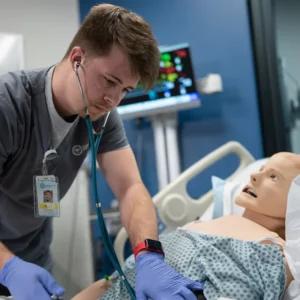If you’ve ever spent time in hospital or if you have asthma as millions of Americans do, the chances are good that you’ve seen a respiratory therapist [1] at work. But do you really know what they do? Here’s a quick look at what the Respiratory Care program [2] at Carrington College is all about.
What does a Respiratory Therapist do?
Life can be tough if you don’t have healthy lungs. You don’t have to be a doctor to know that breathing is pretty important right? Respiratory therapists help patients who have trouble breathing. They work in places like hospitals, nursing care and assisted living facilities, physicians’ offices or make home care visits. Tracy, a Respiratory Care program director at Carrington said, “A respiratory therapist does it all. They’re the ones in the hospital who put oxygen on you, who give you a breathing treatment when you’re having an asthma attack. They are the ones who run your life support in the ICU.”
What will I learn in Carrington College’s Respiratory Care program?
Carrington’s Respiratory Care Associate Degree program takes about two years[3]; you’ll be taught how to administer medical gases and oxygen therapy and to make recommendations for diagnosing and treating cardiopulmonary diseases. By the way, cardiopulmonary is a medical term that means related to the heart and lungs. See, you’re learning already! You’ll also learn how to use the correct techniques to handle emergency situations like performing CPR, clearing a person’s airway and so much more. To know how the respiratory system works, you have to have a pretty good idea about how the whole body works and how it all connects with the lungs. RC program instructor Steve explains, “We start with the very basics from how the body works, to anatomy and physiology; the real simple stuff like cellular structure all the way up to organ systems.” Our program is built to provide you with the training you need to take the NBRC credential exams (National Board of Respiratory Care), such as the Therapist Multiple Choice (TMC) exam and the Clinical Simulation Exam (CSE).[4] Student Rebecca explains why it’s important to learn about the whole body and not just the lungs while you’re studying to become a respiratory therapist. “If there is any complication to our organs, especially our lungs, it will affect every other part of our body.”
What will do I do in the lab?
The lab is where students get the chance to get hands-on and put the things they’ve read in their books and heard about in class into practice. Carrington College students get to practice their work on simulation manikins. RC instructor Steve explains the benefits of using manikins to practice skills. “The manikins here are great! They are very high end – heart sounds, breath sounds, bowel sounds. They are very lifelike. Students can check carotid [neck], brachial [elbow], radial [wrist] pulses, – everywhere they would [on a real patient] in a hospital, and it’s very realistic. If they mess up in here it’s okay, they can say “oops” and “uh oh” in the lab; they’re not phrases we like them to use in the hospital.” Student Felicia tells us that it’s super-useful to be able to do these things in ‘almost’ real-life situations. “We’ve learned about signs and symptoms of certain cardiopulmonary diseases, and what it looks like when a patient is going into respiratory failure. To be able to apply all that on these manikins is very helpful.” Les, another RC student, says he’s learned a lot about diseases on the program, and how they affect the body, particularly the lungs. Student Mario shares some of the hands-on things he’s done in the lab; “We learn CPR and then we can apply it to the manikins; we learned about ABGs [Arterial Blood Gases] which is where we stick a needle in your artery and draw blood to make sure your oxygenation is correct.” Miriam is another Respiratory Care student at Carrington. She explains that while there is lots to learn about the body, once you get hands-on in the lab and practice the stuff you’ve read in the books, it gets easier to understand; “First when you look at it, it’s complicated, but when you come to the lab and apply it to the manikin, it’s really easy.”
Will I get to do some clinical work?
Yes you can get some invaluable hands-on experience out in the real world during the program, and it can be very, very real, as students Mario and Miriam shared. “I did six weeks at my clinical rotation in Tempe, AZ. I saw a lot of life threatening situations that respiratory therapists had to respond to,” said Mario. “I came running when I heard the call; I was the first one in the room and I got to perform CPR on the patient…and he survived,” explained Miriam.
Why did these guys choose a degree in Respiratory Care?
As humans, there’s nothing more important than being able to breathe. Although it wouldn’t be fun, our bodies can survive for a few weeks without food, without water for maybe a few days, but we can’t do without oxygen for more than just a few minutes without risking serious brain damage. So if you’re looking for a health care career where you can make a difference, helping people to breathe is really a no-brainer! Here’s why these guys chose a career as a respiratory therapist. “My whole family is in medical; my sister-in-law has actually been a respiratory therapist for about 20 years. Before I came to school I was an EMT,” explains Les. Jen did some shopping around before deciding that the Respiratory Care program was right for her; “I looked at a few different colleges, talked to a few people who had gone here before and they were all satisfied with their learning and their instructors. So I came, took a tour and went ahead and signed up!” We’ll give the last word to Respiratory Care student Rebecca, who sums up her favorite part of the program in just a few important words… “We save lives!”
So what are you waiting for?
Click here to learn more about the Respiratory Care program at Carrington College.
[1] Individuals seeking to enter this career field may be subject to screenings such as, but not limited to, criminal background checks and drug/alcohol testing prior to externship, to attain occupational licensure/certification or employment and throughout their careers. [2] Important information about the educational debt, earnings, and completion rate of students who attended this program can be found here. [3] Not including breaks. Program length by weeks and admission requirements can be found here in the academic catalog. [4] Carrington College prepares students to take appropriate certification and licensure exams related to their individual majors. The College does not guarantee students will successfully pass these exams or be certified or licensed as a result of completing the program. Credential preparation varies by location.



